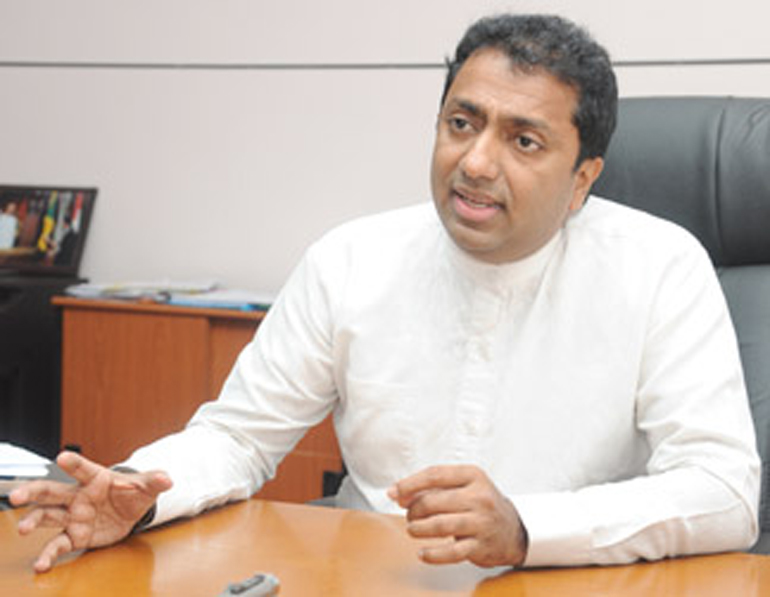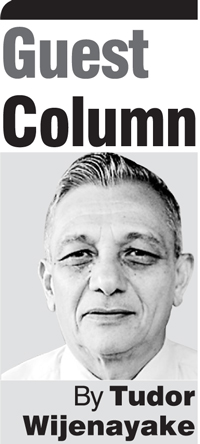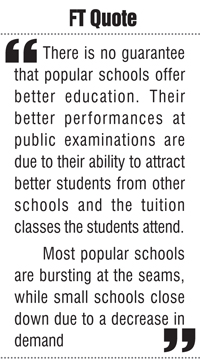Tuesday Dec 23, 2025
Tuesday Dec 23, 2025
Saturday, 20 June 2015 00:00 - - {{hitsCtrl.values.hits}}

Education Minister Akila Viraj Kariyawasam
Last week a discussion on a Sinhala radio channel brought up interesting facts about current yet little-known education practices in Sri Lanka. The discussion’s participants included two veteran trade union leaders from the education sector, one of whom was supporting the Government. During the course of the program, the channel managed to get the Secretary to the Ministry of Education to join in the discussion and later brought in Education Minister Akila Viraj Kariyawasam.
School fees
The topic of the discussion was the fees various government schools charge their students. The participants revealed, with supporting evidence, that several leading schools charge students Rs. 10,000 to 15,000 per year for Advance Level classes, to cover additional expenses incurred.
This money is spent on the school buildings, electricity bills, sports programs, computer labs maintenance, toilets, swimming pools and security. The schools get huge electricity bills due to their computer labs, lighting and, in the case of some classrooms, fans. The department is unable to meet these expenses.
The unionists allege that funds were earlier collected by School Development Societies. However, after the ministry circular of 5/2015, with the approval of the Ministry, the letters are signed by the Principal himself.
The Secretary explained that a leading school in Colombo had a budget of Rs. 60 million, which was carefully scrutinised and the ministry supported the school with Rs. 15 million. The burden to students was also reduced to around Rs. 13,000 per student. The Minister revealed that the Government expected to increase its contribution to education from the current 1.8% of GDP to 6% gradually and a higher contribution would be possible in the years to come.
Reducing class size
The Education Ministry issued a circular to schools informing them of its policy of admitting a maximum of 35 students to a class from January 2016. However, the Ceylon Teachers Service Union, in a public statement, said that the Ministry of Education had no proper system in place to limit the number of students entering Grade 1 to just 35. The union also claimed that the circular did not indicate class sizes above Grade 1 and politicians would continue to introduce students to the higher grades.
The ministry supplies schools with a teacher for every 23 students and the ministry has a teacher population ration of one per every 20 students. But some popular schools have more than 60 students in a class, leading to teachers idling, while at rural schools with small student numbers a teacher is forced to look after two to three classes.
End of free education
During the discussion, the Ministry of Education agreed that students were charged fees and that principals were authorised to collect fees. Meanwhile, rural schools continue to charge a nominal Facilities Fee, but popular schools with extra facilities levy charges as high as Rs. 15,000 a year.
The trend indicates that free education has ended in Sri Lanka.
The radio discussion also revealed that circular 15/2015 allows school principals to gain approval from the ministry to collect funds from students in order to balance the school budget. If this precedent is established, in every popular school the Past Pupils Association and Principal will produce a school budget and levy charges to develop school facilities.
When C.W.W. Kannangara introduced free education, schools had only basic facilities such as a building with a roof, a blackboard and a few benches for students.
He foresaw that one day the country would not be able to afford free education. But he would never have imagined computer labs, swimming pools, sports complexes, fans, security guards and toilet cleaners in schools. The amenities are introduced at the request of parents who, with the standard of living rising, have led schools with inadequate facilities aspire for more.
School admission
The ministry also said that applications for admission to Grade 1 close on 1 July and they lacked time to modify the admission system. The school admission criterion is based on the distance from the residence to the prospective school and other complicated requirements. Many parents use forged documents, bribery and various other unethical methods to admit their child to a popular school.
Having forged addresses and documents, the child meets true society when facing the school admission interview. The child is fed with a series of lies for weeks by its parents prior to the interview, in order to convince the School Admission Board.
The impact of these lies on the child cannot be ascertained but they are sure to have a traumatic effect. Or will this be a starting point for a selfish, self-centered life which will continue through to university admission and employment?
Meanwhile, various organisations have urged the Government to abandon the conduct of the highly controversial Grade Five Scholarship Examination, claiming that the exam did more harm to young children than good, due to the fact that the competition was extremely stressful for a 10-year-old child.
Grade 5 test
The Grade 5 examination commenced to present an opportunity to poor students from less privileged schools to gain financial support from the Government (bursaries). Currently, the Grade 5 Examination presents a second chance to those who have missed out on gaining admission to a reputed school.
Parents send their children to tuition classes, depriving them of time to play, just so they can gain admission to a better school. Parents admit that the sacrifice made by the child is not worth the benefit but are unaware of another solution.
Popular schools
Most of today’s popular schools had their beginnings nearly a century ago, when religious organisations and philanthropic citizens donated lands, buildings and established schools. These schools were for the entire community and not for the children in the locality.
Today, priority in admission is given to proximity but popular schools in Colombo have school buses travelling to towns nearly 50 km away, where students actually live.
Why do parents take such measures to admit their children to a popular school? Simple, because popular schools possess better buildings, classrooms, libraries, sports and prestige. There is no guarantee that popular schools offer better education. Their better performances at public examinations are due to their ability to attract better students from other schools and the tuition classes the students attend.
Most popular schools are bursting at the seams, while small schools close down due to a decrease in demand.
 The cost of free education
The cost of free education
The State was supposed to give every child a free education, but is education really free? The basic textbooks are given free but, as shown above, most schools levy fees under various pretexts for the provision of facilities not funded by the Education Department.
The education cost includes books, stationery, buses or vans to travel to school and tuition costs, in addition to the costs and time incurred by parents in transporting their children to tuition. The country’s education system includes neglected schools without facilities in rural areas, those in the midst of cities, moderately-serviced schools and better equipped, privileged city schools.
The provision of equal facilities to all schools can never be achieved but some equality can be achieved if the Government supplies more facilities to less popular schools. Government funding currently stands at 1.8% of GDP today.
The Government’s inability to provide reasonable education to children resulted in fee-levying schools called International Schools, where parents pay for education, mushrooming. Parents weeded out by the distance rule and those unwilling to resort to unethical practices preferred such schools.
Tuition culture
Unfortunately, most government schools do not provide proper education and the child gets educated through tuition classes. Tuition costs can vary from a few hundreds to thousands of rupees a month per subject.
Affluent parents get tutors to visit home, forking out over Rs. 10,000 a month. Most tutors are teachers from government schools. After hard work in the evenings, the teachers rest during school hours. But when results are published, the schools claim credit for the children’s performance.
Alternative to present system
Society accepts that a child’s admission to a popular school has enormous value. If so, why should a high-value, in-demand product be given free, especially when the country’s education needs so much funding and the Government is short of funds?
This writer proposes that admission and education in popular schools should not be free, but be chargeable with an admission fee and monthly fee. The fees can vary from school to school depending on popularity and demand. The schools can be divided into three categories: Free schools, Nominally-paying schools and Fee-levying schools.
Free schools
Free schools will not require any payment from their students. The Government will issue books as well as uniforms free of charge. The students can also be given a free midday meal.
2. Nominally-paying schools
Nominally-paying schools will charge roughly Rs. 100 to 250 per month per child, covering school expenses and children would be issued free textbooks.
3. Fee-levying schools
The Fee-levying schools would be subject to an admission fee and a monthly payment. The Education Department allocates a teacher to every 23 students. The teacher’s salary alone costs over Rs. 1,000 per student per month and could be the basic charge for a not-so-popular fee-levying school.
In popular schools, charges could vary from school to school depending on popularity and demand. Even at the proposed fee levels, there would be enormous demand and the ministry would have to arrive at a selection criteria.
The admission fee may be Rs. 25,000 for a not-so-popular school and could be increased along with popularity. The suggested fees are much lower than those at International Schools and the demand would be heavy.
Auction of admissions
If the current admission criteria are continued, students away from the school, who are not children of past pupils and those without brothers or sisters in the same school, will not have an opportunity.
It is proposed that 25% of positions in Fee-levying schools be auctioned, with admission given to the highest bidder. This would bypass the underhand admissions, with bribery replaced with an open payment system which channels funds into the education system.
Grade 5 examination
The Grade 5 examination would be open only to students from Free-schools and the Nominally-paying schools, with 50% of the places in Fee-levying schools filled with children passing the Grade 5 examination.
At Grade 6, the school fees would be revised to accommodate the cost of scholarship students. The scholarship students in Fee-levying schools would not be given free books or uniforms, but a cash payment in lieu of a scholarship to avoid superficial difference between students.
Reduction in class numbers
Class numbers in Fee-levying schools need to come down to 25, allowing teachers to pay individual attention to students. Reduced student numbers in popular schools will increase numbers in rural schools, preventing the closure of small schools.
Class tests
Class tests with question papers prepared by the Ministry of Education could continue, but from Grade 6, children in Fee-levying schools falling below a stipulated grade would be expelled after a warning.
Scholarship children who have achieved high standards will need to maintain these high levels (say above 60%), otherwise the scholarship would be withheld and repeaters returning to the old school would keep every student on their toes.
Grade 8 examinations
During British rule and some years afterward, an examination was held for Grade 8 students. This test was abolished in 1956. In rural schools, as well as in non-popular urban schools, some students are not interested in studies but are promoted every year. These students obstruct others and are a nuisance. These uninterested students can be weeded out at the Grade 8 examination and be guided to a trade or agricultural school.
Usage of funds
The establishment of Fee-levying schools will result in a substantial collection of funds. Large numbers of schools lack science and IT laboratories, forcing students to follow the arts stream. The collected fees could be used to upgrade facilities in Non-fee levying schools.
International Schools
International Schools require spacious lands and buildings and demand high financial commitments, resulting in high charges for students. In addition, they all have expansion programs that need funding.
Existing government schools need little or no further capital investments and need only to meet current expenses. Therefore the Government could provide similar services as International Schools at a much lower cost.
Integrity of the citizens
A topic which surfaced during the past few months of political uncertainly was the honesty and integrity of our politicians. The discussions pointed out that the politicians were responding to the demands of voters and the principle item disrupting the honesty of the public was the current school admission system, where the public creates bogus documentation and seeks undue assistance from politicians to admit their children to popular schools.
The fees presently charged by popular schools have not elicited complaints from parents, indicating that most parents are capable and willing to pay for their children’s education. When the school fees become streamlined, parents will demand quality education without the need for tuition.
The restriction of the Grade 5 examination to non-paying schools would reduce the culture and demand for tuition. With reduced demand for tuition, teachers will focus more on their teaching, breaking the tuition cycle and improving education quality. The reduction of tuition will give children more time to play and cause them less stress.
The Fee-levying government schools will offer competition and an alternative to private schools. State schools are already established in better locations with more space and lands, giving students their money’s worth.
The current so-called free education with tuition is expensive in terms of money and demands parents’ time. With better quality school education and reduced tuition costs, the school fees payable will not make much difference to the parent’s pockets.
With Fee-levying schools filled with affluent students, Nominally-paying schools will be in demand and the quality will improve. Being closer to their homes, children will have more time for sports and cultural activities. As Fee-levying schoolchildren will not be eligible for scholarships, those less privileged will have better opportunities to get scholarships and admission to better schools.
The proposals will bring about a win-win situation for all children and will eradicate the primary reason for the breakdown of honesty in society, by eliminating forged documentation and the lies which small children are forced to speak.
The above proposals would eliminate political interference in school admissions, as parents could select a school of their choice, based on their ability to pay. Parents would not need to ask for political favours or resort to other unethical practices, resulting in a cleaner society. The politicians themselves would not interfere with school admissions and the administrators would be free to work according to their conscience.
(The writer is a Chartered Civil Engineer who graduated from Peradeniya University and has been employed in Sri Lanka and abroad. He was General Manager of the State Engineering Corporation of Sri Lanka. He can be contacted on [email protected])